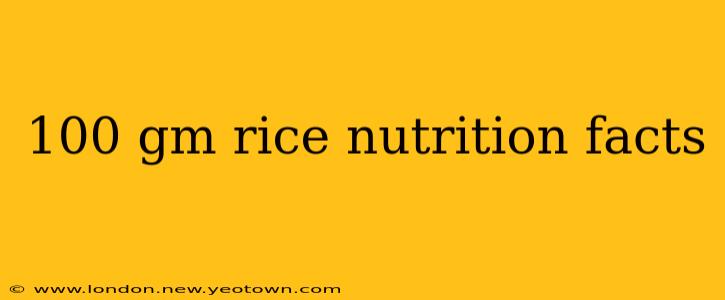Unpacking the Nutritional Powerhouse: 100 Grams of Rice
Rice, a staple food for billions worldwide, comes in countless varieties, each boasting a unique nutritional profile. But let's focus on the nutritional facts for a standard 100-gram serving of cooked white rice, and then explore some frequently asked questions about its nutritional value. This isn't about dry weight; we're looking at what you actually consume after cooking. Remember that the specific nutritional content can vary slightly based on the type of rice, growing conditions, and cooking methods.
The Basics: A 100-gram Serving of Cooked White Rice Typically Contains:
- Calories: Approximately 130-140 calories. This makes it a relatively low-calorie food source, ideal for those watching their weight.
- Carbohydrates: This is where the bulk of the energy comes from – around 28-30 grams, predominantly in the form of starch.
- Protein: A modest amount, typically around 2-3 grams. Rice isn't a primary protein source but contributes to overall daily intake.
- Fat: Negligible amounts, making it a good option for those limiting fat consumption.
- Fiber: Relatively low in fiber compared to brown rice, usually around 0.4-0.6 grams.
- Vitamins and Minerals: While not a powerhouse of vitamins and minerals, white rice does contain small amounts of thiamine (vitamin B1), riboflavin (vitamin B2), niacin (vitamin B3), and iron.
Frequently Asked Questions about Rice Nutrition:
1. Is white rice healthy?
White rice, while not as nutrient-dense as brown rice, still provides energy from carbohydrates. It can be part of a balanced diet, but moderation is key. Its low fiber content means it might not be the best choice for those seeking high fiber intake. The processing of white rice removes the bran and germ, leading to a loss of some vitamins and minerals compared to brown rice.
2. What are the differences between white and brown rice nutritionally?
Brown rice is significantly more nutritious than white rice. The bran and germ layers, removed during white rice processing, contain essential nutrients like fiber, magnesium, and various antioxidants. Brown rice has a higher fiber content, promoting better digestive health and contributing to a feeling of fullness, which can aid in weight management. It also offers a richer profile of vitamins and minerals.
3. How many carbs are in 100g of cooked rice?
A 100-gram serving of cooked white rice contains approximately 28-30 grams of carbohydrates. Brown rice will have a slightly higher carbohydrate content, but much of that is in the form of fiber.
4. Is rice good for weight loss?
Rice, particularly white rice, can be part of a weight loss plan, but only when consumed in moderation as part of a balanced, calorie-controlled diet. Its relatively low calorie count compared to other carbohydrate sources makes it a viable option for some individuals. However, the low fiber content of white rice might not promote the same feeling of fullness as brown rice, which might aid in weight management.
5. What are the glycemic index (GI) values of different types of rice?
The glycemic index (GI) measures how quickly a carbohydrate-containing food raises blood sugar levels. White rice generally has a higher GI than brown rice, meaning it causes a quicker rise in blood sugar. Different varieties will vary slightly, but this is a key difference between the two. Individuals with diabetes or those managing their blood sugar should be mindful of the GI value of the rice they consume.
Conclusion:
A 100-gram serving of cooked white rice offers a moderate source of energy, but its nutritional value is enhanced by incorporating other nutrient-rich foods in your diet. Brown rice offers a superior nutritional profile, providing more fiber, vitamins, and minerals. Choosing the type of rice that best suits your individual dietary needs and preferences is crucial for maintaining overall health and well-being. Remember to consult a healthcare professional or registered dietitian for personalized dietary advice.

